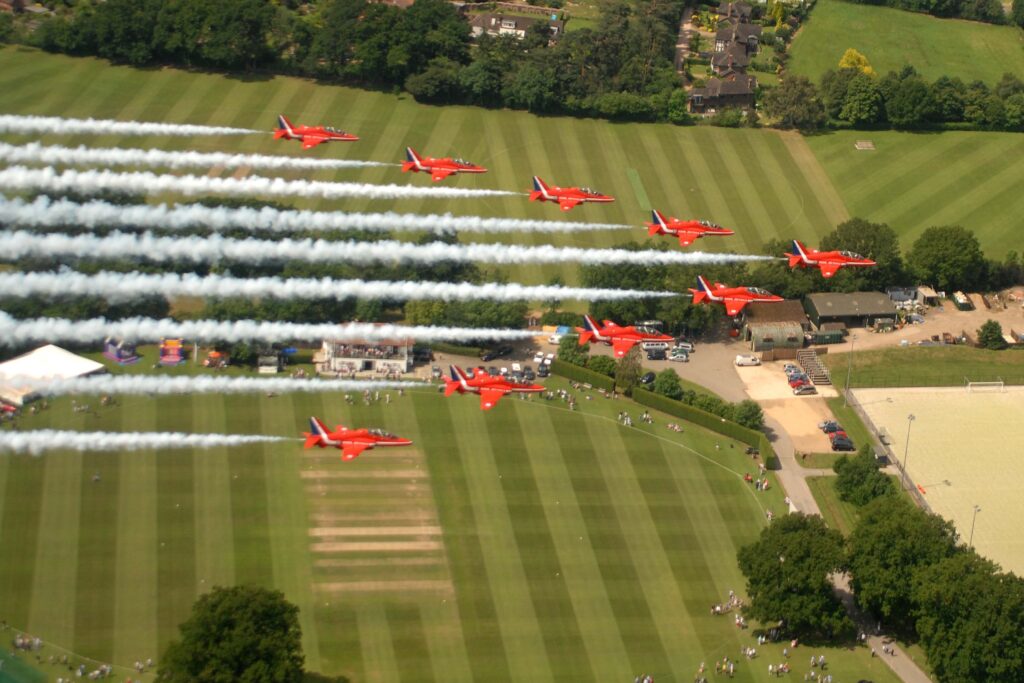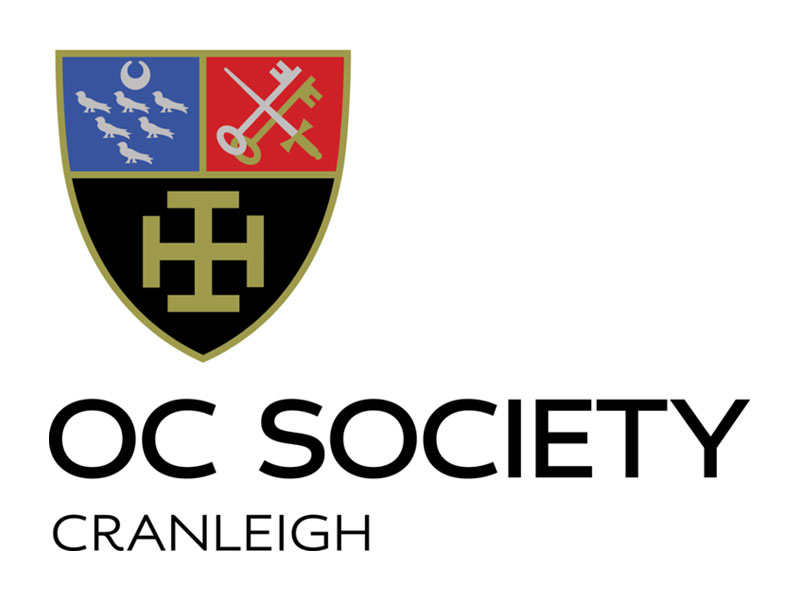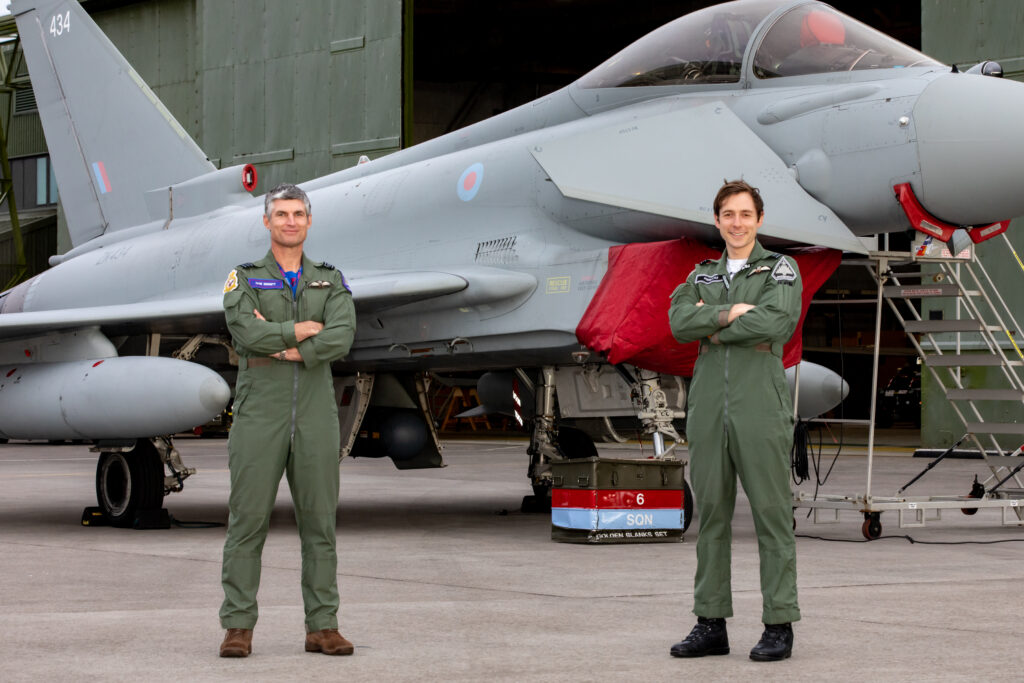There are many steps in the journey from Cranleigh pupil to frontline fighter pilot. We spoke to two OC squadron pilots to discover the paths they took. Two things they both agreed on: the busy and challenging Cranleigh environment was a great grounding for a high-flying career – and one should never take no for an answer!
Both Flight Lieutenant Peers Lyle (Loveday 2010) and Squadron Leader Zane Sennett (2&3 South 1994) were music scholars and sportsmen as well as academics and House Captains. Since those days, their RAF careers have brought them intense training, firm friendships, incredible skill and taken them all over the world having experiences that schoolboys can only imagine. Both are now based at RAF Lossiemouth in Scotland where they bumped into each other earlier this year.
When you were still at Cranleigh and deciding upon your A Levels, what did you have in mind for your future career?
ZS: I had always been interested in flying and aviation generally. I was very naïve however, as to the reality of turning that interest into a career. My father was a pilot, he trained initially with the RAF before moving into civil aviation. He flew for Cathay Pacific, and I was born and lived in Hong Kong. My school holiday routine involved flying across the globe regularly and so, with this exposure, I genuinely thought that after leaving Cranleigh I would simply walk through the door of Cathay Pacific and declare: “I’m here to start my flying training.” Needless to say, reality dissolved that naivety! I chose A-Level subjects that I thought I would enjoy (I’ve no idea why I chose economics based on that!) and, prior to going to the University of Birmingham, I worked in a school in New Zealand. It gave me a 12-months to really think about what I wanted to do. My father suggested I enquire about flying in the RAF – and that was it – I was hooked.
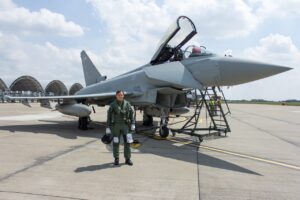
PL: Whilst having the Typhoon as my ultimate goal, I was mindful to try to enjoy the journey and not get too absorbed by the whole process. Subsequently, my A Levels (Chemistry, Biology and Maths) were chosen purely out of interest and they were the subjects I enjoyed the most. Similarly, studying Chemistry for four years at university certainly did little to help me in my aim to fly Typhoons, but they were years filled with great fun, friendship and personal development that I certainly wouldn’t change looking back now. Whilst we all do the same job, the backgrounds of Squadron pilots vary greatly – there is no one-size-fits-all when it comes to upbringing. That is not to say that the experiences I had a school bore no effect on my application to the RAF. Indeed, undergoing selection during my Upper Sixth Form meant competing with those older than me from the civilian world, and I drew on my experiences from Cranleigh to help me appear attractive to the RAF. Whether it was the time-management from juggling being a Music Scholar, keen on the sports field and academics, or the unique situations I found myself having to deal with as House Captain, my experiences at Cranleigh were the makeup of my application.
You were both music scholars – was music ever something you were going to pursue? You were also both House Captains, do you think that’s significant?
ZS: I enjoyed my music – but I don’t think I was a classic music scholar at Cranleigh! I was more naturally into sport, particularly rugby. Although I was involved in the majority of the musical activities, I was also fighting a conflict with the sporting commitments that I had. More often than not, I think I let sport take over! I still possess my trumpet and violin, and for a few years I used to play at friends’ weddings. Currently, both instruments have seen better days, and they would certainly require a thorough dusting-off before producing any passable sound nowadays!
How did Cranleigh inspire your career journey?
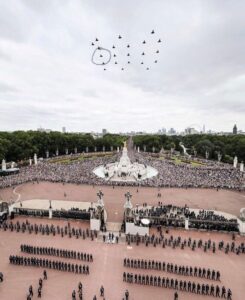
ZS: Cranleigh provided an unrivalled exposure to a wealth of opportunities. When I was at school I felt that it provided a great balance. Whilst I perhaps did feel like there was an expectation to go immediately on to university, it wasn’t an over-riding expectation. I did go on to university, but it was my housemaster (Gareth Jones, MCR 1978-1998) who was instrumental in highlighting and suggesting a brilliant opportunity to go to New Zealand for a year, beforehand. Indirectly, that allowed me to really explore exactly what opportunities were available. Cranleigh also gave me a lot of confidence to engage and talk to people. I’ve found that I have never had a problem in starting a conversation, nor have I felt any kind of personality gradient with people I’ve met. This has certainly helped my career in the RAF: whilst WhatsApp dominates social media, there is no substitute to talking directly, face-to-face! A lot of my job involves mission briefing – you have to be confident in this. It backs up your credibility and helps inspire people.
PL: My first exposure to life within the RAF was through the AFCO (Armed Forces Careers Office). I initially wanted to be a doctor in the Army, and only when a friend (who is now an Army Vet) placed the brochure for the RAF on my desk did the idea of becoming a fighter pilot take hold. I was then incredibly fortunate to be supported by family, friends and the staff at school as it became a real focus for me alongside school life. My sister, Victoria Turner (nee Lyle, West 1999-2003) also joined the RAF during this time, adding further motivation and offering me a real insight into the world of Military aviation. Being seven years my senior, she has recently been flying Typhoons as an Instructor and has been a great friend throughout the whole journey.
Were you involved with CCF at school?
ZS: During the year I spent in the CCF, I was perhaps the worst cadet ever! There was no RAF section of the CCF at my time in Cranleigh – but I was obviously drawn to military ethos. I was only able to serve a year, because I just couldn’t balance my sport and music commitments. My infamous highlight was during a weekend “tactical exercise” near Aldershot. I remember that we were meant to be on sentry duty: making sure no one encroached into the camp area. I was struggling to heat this “meat-in-a-can” thing and became totally task saturated. The next thing I saw was a large pair of boots and looked up to see a “not too happy” Major Ayres (who ran the CCF). He had managed to simply stroll up, unchallenged through the lines in my sector! Let’s just say that my brother is the soldier in the family (he served eight years as an officer in the infantry).
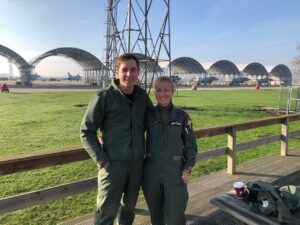
PL: I was a member of CCF for four years at Cranleigh, and have many fond memories from that time. We had a strong group of friends from Loveday who all joined together, and we found ourselves being offered opportunities that were unique and challenging. The CCF certainly dispelled (and confirmed!) some preconceptions I had about the military, but it taught me a lesson that has been constant throughout my military career. The military offers you a huge number of opportunities that you would never be able to access in the civilian world. I have been lucky enough to sail the east coast of Greenland, parachute, play sport around the world, climb some incredible mountain ranges, learn to ski and fly one of the most advanced fighter jets in the world – at supersonic speeds close to 55,000 feet. These are opportunities that are out there, if you’re willing to put the effort in, and the CCF was the start of this journey
What’s your fondest memory of Cranleigh?
ZS: This is a difficult question; I loved many aspects of my school life. I would probably say it was two memories, based around rugby. I was fortunate to play for the 1St XV, in the second half of the season, when I was in the Upper Fifth. What this meant was that I played alongside my brother, Dan (1North 1988-1992), who was 2 years above me. We both played on the flank – and I believe that this was the first time that 2 brothers had played in the 1st XV together at Cranleigh. I was honoured to be Captain of the 1st XV in my final year (’93-94). We had a superb team; we had always been strong, from U14s through to the Colts, but in our final year we achieved an unbeaten season. It was the first such unbeaten season since 1955. Unfortunately, I sustained an injury in the second half of the season, which meant I couldn’t play the final few matches. I was disappointed to miss the final game against Wellington College, because the opposition prop ended up as my housemate at university. I never let up on the banter though! The OC Rugby Club organised a gathering and presentation at the Thames Ditton Clubhouse – the highlight of this was getting a kiss from the legendary Samantha Fox, who graciously stepped-up to present after Will Carling had to cancel at the last minute! Another fond school memory was 2&3 South winning the esteemed “House Singing competition” for five straight years!
PL: My time at Cranleigh was memorable for so many reasons, and it’s impossible to list them all. Whether being thrown into the school’s Les Misérables musical in the Fourth Form, time spent on the hockey and cricket pitches or the memorable times in The Old Barn in Lower and Upper Sixth, the memories and friendships from Cranleigh will always be ones to be cherished.
What inspired you to join the RAF and start the journey to where you find yourself now at Lossiemouth?
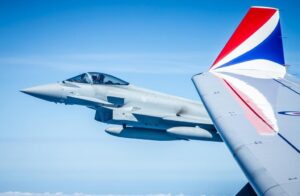
ZS: My flying inspiration came from my father and the exposure to aviation that I gained from him being a pilot. He had flown in the RAF (Vampire, Meteor and Canberra aircraft) before transferring to commercial aviation. During my GAP year in New Zealand I began to seriously enquire about the RAF selection and joining procedure. The more I found out, the more I wanted to join.
Flying with the RAF has taken me everywhere, from training establishments in the UK and Canada; military exercises across Europe, the US and Australia through to military operations in Afghanistan, Iraq and Syria. My current tour at RAF Lossiemouth involves flying the Typhoon on one of the RAF’s Front-Line Squadrons.
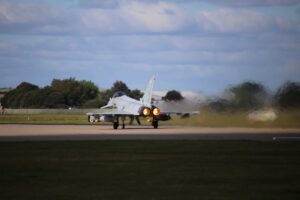
PL: Once the idea of being a fighter pilot became my focus, my next step was to check I wasn’t barking up the wrong tree. I cold-called RAF Coningsby, a Typhoon base, and asked if they’d have me along for a week during the summer holidays after my GCSEs, they kindly agreed. I sourced a BnB which said they could look after me, though I’m not sure my Mother was impressed when I had to ask them to ring her with the bill! My week at RAF Coningsby was incredible – standing next to these machines and watching the pilots conduct their day-to-day business. From that moment, I was truly hooked.
Can you give us a summary of the key stages of your career so far – including what training you had to undertake for each stage?
ZS: I started official flying training whilst I was on the University of Birmingham Air Squadron. These small units existed to expose undergraduates to both flying and RAF life. You joined as a “reservist” with the aim of completing RAF regular selection during your time at university. I flew approximately 90 hours (of which 20 were solo) on the Bulldog aircraft – a side-by-side elementary trainer. I was fortunate to pass my full RAF selection in 1998, which meant I would attend Initial Officer Training at the RAF College, Cranwell, Lincolnshire on leaving university that summer. At this time in the RAF, pilots got “streamed” into one of three streams (Fast Jet/Multi Engine/Helicopters), depending on your performance on the Bulldog. I was very lucky to get posted to Fast-Jet training.
Basic Fast-Jet training took place at RAF Linton-on-Ouse in Yorkshire. It was a 10-month course flying the Tucano, a high-performance turbo prop. This was a massive leap from the small bulldog: it was a sleek airframe, and over twice as fast. Flying training is a building-block approach, where you simply consolidate skills whilst advancing to bigger and faster platforms. In my opinion, the Tucano course is where students learn to be “pilots”. It was an enjoyable course and, being 10 minutes away from the nightlife in York, RAF Linton-on-Ouse was a fantastic place to be stationed!
Advanced fast-jet training continued at RAF Valley, Anglesey, flying the Hawk. This was massively exciting as it was the first proper “fast jet” that I had ever flown. Flying training from now on focussed not so much on “raw flying” (this was meant to have been completed on the Bulldog and Tucano) but significantly more on “operating” aircraft. Front-line fighter aircraft are, first and foremost, weapon systems; as a pilot of one of these platforms, you must operate the weapon system according to whatever task you have been set. The training system aims to shift brain power less to “flying” the aircraft…to more “operating” the aircraft.
On completing this course, I was selected to become a Hawk instructor. This was not what I wanted to do at this stage: I wanted to progress straight on to further training and the front-line as soon as possible. Unfortunately, I got my first taste of “what the RAF needs versus what you might want!”. So began a 3-year tour instructing pilots (all of a similar age) on the Hawk course that I had just completed. Whilst it was frustrating, I finished the tour with 1000hrs+ fast-jet flying and instructional experience, which was going to be extremely useful going forward.
The next stage was to complete Tactical Weapons training – a course conducted on the Hawk which was dedicated to learning and honing the skills required to fight and operate the aircraft as a weapon system. I had the opportunity to complete this in Canada, at a NATO school hosted by the Royal Canadian Air Force. They operated a brand-new version of the Hawk (think digital rather than analogue) and so I jumped at the chance to fly it. The 6-month course was superb; I trained with Singaporeans, Hungarians, Italians and Canadians. One of the remarkable things is that I have been re-acquainted with all these other pilots during exercises and operations around the globe…some good reminiscing was had!!
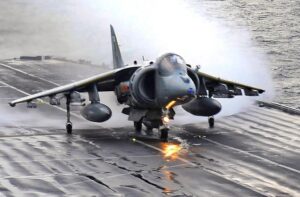
Following training, I was posted to fly the Harrier, which would be my first Front-Line combat aircraft type. The Harrier was an amazing platform. Notwithstanding its unique ability to hover, it was also superb in its role: ground attack. As a member of 1(Fighter) Squadron, I took part in exercises around the world, flew off the aircraft carrier HMS Illustrious, and conducted 4 operational tours in Afghanistan.
After my Front-Line tour, I was fortunate to get selected to join the RAF Aerobatic Team, The Red Arrows, for the seasons 2009-11. The 3 years spent on the team was an amazing experience. Whilst it was a distinct break from the tactical nature of operations, the flying was simply exhilarating. I thrived on the close-knit aspect of teamwork and enjoyed displaying in some of the most amazing locations around the world – none more so than Cranleigh School in 2011! After some high-level coordination, masterminded by Rick Johnson (1 North 1986-1991 years) and the Cranleigh Foundation, we were able to conduct a display over the prep-school orchard. It was a once in a lifetime opportunity. I had arranged all the air traffic coordination… which had to be watertight as we were displaying directly below the climb-out lane for London Gatwick! Fortunately, no gin and tonics were spilt that day…!
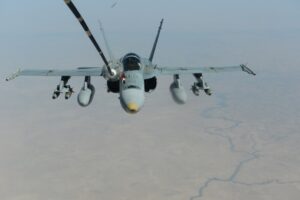
At the end of 2011, I transferred to the Royal Australian Air Force (RAAF), where I flew the F18 Hornet, an aircraft that I had always wanted to fly. I found the transition extremely difficult, and it took me a while to actually get qualified on the aircraft. This was my first exposure to a true multi-role fighter, which had a radar and missiles. Having been a “ground attack” pilot, the “Air-to-Air” role was completely different. Three-years away from tactical operations on the Red Arrows, coupled with the fact that I knew nothing about the Australian “system”, meant that it was not plain sailing. However, once I got qualified, I had a remarkable experience in the RAAF, conducting exercises all over the south pacific, whilst also flying on combat operations in Iraq as part of the coalition campaign against Daesh.
I re-joined the RAF in 2017, whereupon I converted to fly the Typhoon. It is a true multi-role fighter, with a potent arsenal of both air-to-air missiles and a suite of ground attack munitions. This is the third front-line platform that I’ve flown. Whilst my time on the F18 Hornet was invaluable, it still requires a significant re-datum to a different system. There are similarities across all “fighter types”, of course, but they are still all different, which means you have to master all of those small differences… and that gets harder as you get older! I’m currently posted to 6 Sqn, RAF Lossiemouth, in Scotland.
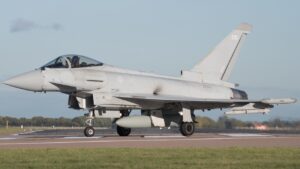
PL: My RAF career started at university with the University Air Squadron (UAS), where I spent the four years of my university career learning to fly while I studied. For many future pilots, the UAS is their first exposure to RAF life, and as I was sponsored though university by the RAF, I very fortunately had automatic membership. To leave lectures on a Wednesday and then be flying at RAF Benson in Oxfordshire in the afternoon, whilst being paid, was a surreal university experience, and one to be recommended!. Once I had graduated from university, my RAF career started in earnest at Initial Officer Training at RAF Cranwell in Lincolnshire. This course is continually undergoing adaptations, but when I joined over six years ago it was a 30-week course, with leadership lessons, exercises in the field, plenty of fitness training and academics that culminated in the awarding of a Commission – a proud day in front of family and friends. Phase 2 training started shortly after, and here started the long process of flying training. Nine months on a Grob Tutor aircraft at RAF Wittering by Peterborough, a year on the Tucano T1 at RAF Linton-on-Ouse by York and then on to RAF Valley for Advanced Jet Training (AJT) on the Hawk T2. AJT was the real test – up until this point the training had been focused on flying and building airmanship skills, but at AJT we learnt how to fly and fight jet aircraft – a massive step up. 18 months, and two very wet and windy winters in North Wales later, and I moved to RAF Coningsby in Lincolnshire where the whole journey had started for me. Here I first flew the Typhoon FGR4 on the Operational Conversion Unit 29 Squadron, where we got to grips with this incredible machine. The nine-month conversion course finished towards the end of 2020, and since then I have been on the frontline with II(AC) Sqn at RAF Lossiemouth in North Scotland. The process of flying training isn’t as smooth as one would hope, but that is part of the journey – patience is key. I was fortunate to spend some of the ‘holds’ between the flying courses in interesting jobs. The first was working for a 2-Star General in HQ Air Command, but the highlight of my holding periods was doing a War Studies MA at King’s College, London for a year, looking at how terrorist organisations were using commercially bought drones to have a pseudo-air force. For now though, six-and-a-half years of training is complete, and I have started my first three-year tour on the frontline, excited for the opportunities to come.
What has been the best or most exciting part of the journey up to this point?
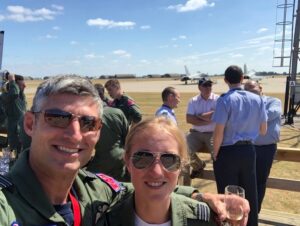
ZS: This is an exceedingly hard question to answer; one of the things about military life is that it can deliver many things – both planned and unplanned. The unplanned part of it is actually something that I particularly enjoy (up to a point…!). The RAF has given me some incredible professional flying experiences: I’ve flown combat operations on 3 front-line types, and also been fortunate enough to have flown as part of the best (in my opinion!) formation display team in the world. Equally enjoyable have been the rather random experiences, such as diverting into foreign airfields unplanned…and simply having to make something work!
In July 2018, I flew one of the Typhoons that made up the “100” formation flypast down The Mall, to celebrate 100 years of the RAF. Putting the whole thing together, and then conducting the flypast itself was thrilling. I also got to catch up with Tori Turner (nee Lyle, fellow OC and Peers’ sister), at RAF Coningsby, in Lincolnshire, where the training was conducted.
PL: There is nothing quite like the thrill of flying a fast jet – it’s a unique experience! The power in the Typhoon is something to behold. Plugging in the afterburners for a performance take-off, with 40,000lbs of thrust in your back, and rocketing into the blue yonder in the near vertical is certainly the best way of getting to work. The flying is both the most exciting, and most challenging part – you are in a jet that won’t give you much change out of £100M, with some extremely powerful and potent weaponry on board, so there is no room for error. Unsurprisingly, you have to be on it, every second. The tactics are complicated, the g-force is intense and the standards to hit are immense. However, with suitable application, determination and a desire to learn every day, you very quickly hit achievements previously you might not think possible. Everyone around you is just interested in making themselves, and you, operate at the highest levels whilst being safe – it’s a humbling environment.
What has been the most challenging thing you’ve had to face?
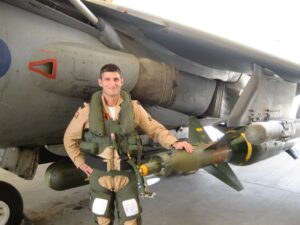
ZS: Operationally, my most challenging experience was during a mission in Afghanistan. I had been re-tasked to provide Close Air Support (CAS) to a coalition patrol who were under sustained fire and had suffered a fatal casualty. Significantly, the patrol did not have a JTAC (essentially a soldier who is specifically trained to talk to and control aircraft, in these situations). It removed certain safeguards that made employing ordinance, so close to friendly forces, have the potential to go catastrophically wrong.
I felt a lot of pressure, but thankfully my wingman and I were able to identify what we needed to do. The forces were able to dis-engage and get back to the safety of a forward operating base. Thankfully, the training kicks in. But it doesn’t remove the anxiousness that I felt immediately prior to this situation. All I could think about was being an effective operator when needed. My job was simple: to support the soldiers on the ground with whatever they needed to survive and I didn’t want to screw it up.
What is the next step (likely to be very different for each of you I imagine)
ZS: I’m reaching a decision point – and may be leaving the RAF in the next few years. I think the only planned step I have, is to have a complete break…and see what other opportunities are out there! I am sure that new opportunities will involve flying in some respect.
PL: Having just joined my frontline squadron, my primary role is to achieve my ‘Combat Ready’ status as soon as possible. This will be an intense period of developing my domestic and tactical flying abilities, before we prepare to hold readiness for UK defence over the summer. With exercises in France and Oman forecast, it will be a busy period!
What advice would you give for an OC hoping for a career flying typhoons?
ZS: Never take no for an answer. My path into the RAF was not seamless. I was initially unsuccessful in both my attempt to get into the University Air Squadron, and my initial application to join the RAF, mid-way through my degree course. Keep striving for what you want…it will happen – maybe just in a different way. So; never take no for an answer!
PL: Flying the Typhoon is a special and privileged position, achievable as long as you’re willing to go for it. As a highly meritocratic system, if you hit the standard required, and there is a cockpit for you, then there is nothing stopping you joining the RAF and passing flying training. The learning is intense, the training arduous and long, but as long as you are motivated, suitably determined and have a willingness to learn, you won’t go too far wrong.
